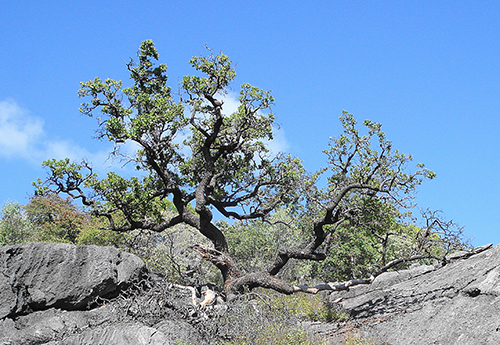• LUISE HOFFMANNNINE different woody ozoroa species occur in Namibia. The leaves of all of them when bruised emit a resinous scent. The veins on their leaves are distinctly parallel.
The Namibian resin tree and the common resin tree (Ozoroa paniculosa) form trees of 5 to 9 m height while the other species are smaller trees or shrubs.
Anyone who likes to climb mountains in Namibia will easily recognise the Namibian resin tree by its very rough dark grey to black bark, which splits into squares with rounded corners. This tree very often grows out of rock crevices on hills and mountains and is almost evergreen. The thick, leathery leaves have a smooth margin and numerous parallel veins.
Names: A Namibiese harpuisboom; G Schwarzborkenbaum – relating to the very dark bark; H omuryahere – this name is also given to Dombeya rotundifolia, the much more common “wild pear” which also has a dark very rough bark and occurs mainly on mountains. The leaves and flowers, however, are very different from those of Ozoroa crassinervia. The Afrikaans and English common names refer to the milky latex exuded by most ozoroas. The scientific name Ozoroa is probably of Arabic origin and refers to smell, while crassinervia relates to the numerous, neat parallel veins of the leaves of the Namibian resin tree.
The distribution of this tree extends along the entire escarpment reaching inland into the Karstveld and the central highlands as well as the entire area south of Keetmanshoop, but is always confined to rocky outcrops, hills and mountains. As the common name implies it is mainly a Namibian species, although it is also found in northern Namaqualand. Beautiful specimens can be seen along the high road in Daan Viloen Park, in the Eros Mountains, the Naukluft, the Otavi Mountains and the Waterberg.
It is usually a single-stemmed tree with a round crown, up to 9 m high. Small, whitish flowers appear in sprays at the tips of the branches in October. The fruit is a kidney-shaped to round, flattened berry, green at first with dark blotches, growing black and wrinkled when ripe.
Remarks: There are no reports on any practical use involving this beautiful tree. However, due to its striking dark trunk and the large velvety leaves it would be a definite asset for any garden in the dry, rocky parts of the country. The seeds germinate easily and, once established, the tree grows quite fast.
For a large variety of seedlings of indigenous plants contact Silke at the National Botanical Research Institute, Tel: 061 202 2014. Also enquire at the forestry nurseries in the various district capitals.
Stay informed with The Namibian – your source for credible journalism. Get in-depth reporting and opinions for
only N$85 a month. Invest in journalism, invest in democracy –
Subscribe Now!






